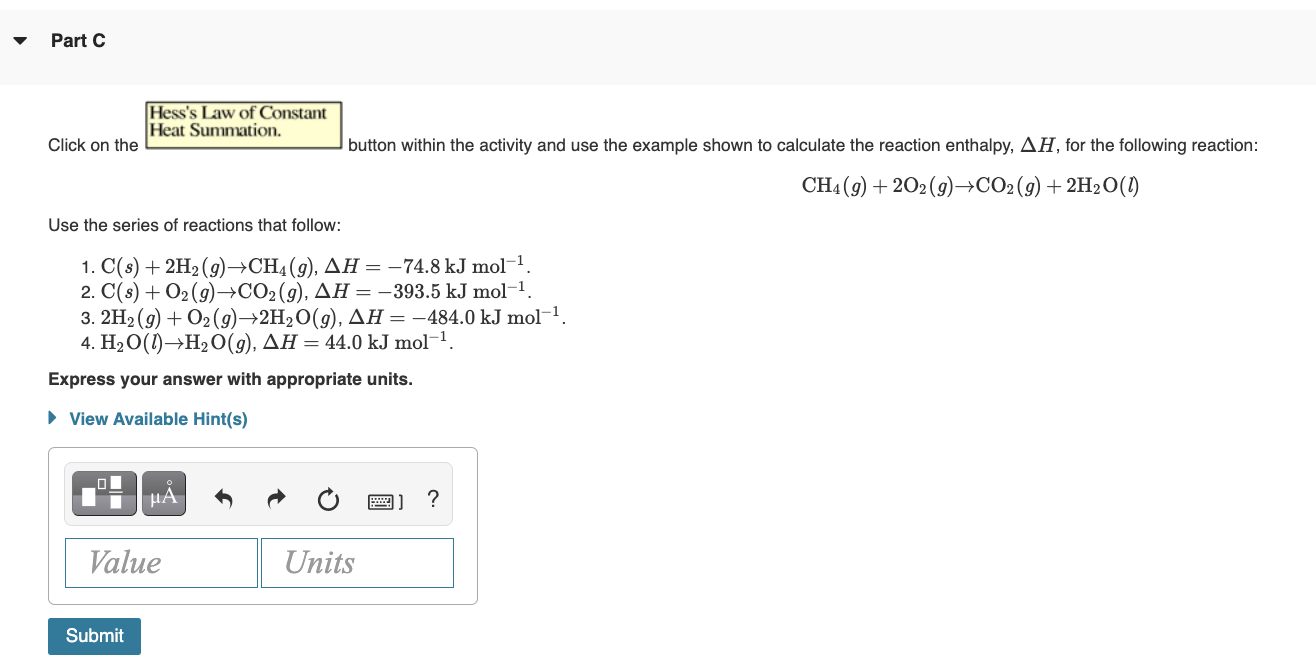Home /
Expert Answers /
Chemistry /
hess-39-s-law-of-constant-heat-summation-example-you-can-calculate-the-reaction-enthalpy-for-the-com-pa383
(Solved): Hess's law of constant heat summation example, you can calculate the reaction enthalpy for the com ...
Hess's law of constant heat summation example, you can calculate the reaction enthalpy for the combustion of solid sulfur, \( \mathrm{S}(s) \), to form \( \mathrm{SO}_{3} \) gas: \[ \mathrm{S}(s)+\frac{3}{2} \mathrm{O}_{2}(g) \rightarrow \mathrm{SO}_{3}(g) \] The combustion of solid sulfur to form \( \mathrm{SO}_{3} \) gas occurs in the two steps. Step 1: \( \mathrm{S}(s)+\mathrm{O}_{2}(g) \rightarrow \mathrm{SO}_{2}(g), \Delta H=-297 \mathrm{~kJ} \mathrm{~mol}^{-1} \). Step 2: \( \mathrm{SO}_{2}(g)+\frac{1}{2} \mathrm{O}_{2}(g) \rightarrow \mathrm{SO}_{3}(g), \Delta H=-99 \mathrm{~kJ} \mathrm{~mol}^{-1} \). both sides of a reaction arrow is cancelled from both sides of the equation. Thus, by adding step 1 and step 2, you can obtain the reaction enthalpy for the overall reaction: \[ \begin{array}{c} \mathrm{S}(s)+\mathrm{O}_{2}(g) \rightarrow \mathrm{SO}_{2}(g), \quad \Delta H=-297 \mathrm{~kJ} \mathrm{~mol}^{-1} \\ + \\ \mathrm{SO}_{2}(g)+\frac{1}{2} \mathrm{O}_{2}(g) \rightarrow \mathrm{SO}_{3}(g), \quad \Delta H=-99 \mathrm{~kJ} \mathrm{~mol}^{-1} \\ \mathrm{~S}(s)+\frac{3}{2} \mathrm{O}_{2}(g) \rightarrow \mathrm{SO}_{3}(g), \quad \Delta H=-396 \mathrm{~kJ} \mathrm{~mol}^{-1} \end{array} \] Hence, the reaction enthalpy for the overall reaction is \( -297 \mathrm{~kJ} \mathrm{~mol}^{-1}+\left(-99 \mathrm{~kJ} \mathrm{~mol}^{-1}\right)=-396 \mathrm{~kJ} \mathrm{~mol}^{-1} \).
Click on the button within the activity and use the example shown to calculate the reaction enthalpy, \( \Delta H \), for the following reaction: \[ \mathrm{CH}_{4}(g)+2 \mathrm{O}_{2}(g) \rightarrow \mathrm{CO}_{2}(g)+2 \mathrm{H}_{2} \mathrm{O}(l) \] Use the series of reactions that follow: 1. \( \mathrm{C}(s)+2 \mathrm{H}_{2}(g) \rightarrow \mathrm{CH}_{4}(g), \Delta H=-74.8 \mathrm{~kJ} \mathrm{~mol}^{-1} \). 2. \( \mathrm{C}(s)+\mathrm{O}_{2}(g) \rightarrow \mathrm{CO}_{2}(g), \Delta H=-393.5 \mathrm{~kJ} \mathrm{~mol}^{-1} \). 3. \( 2 \mathrm{H}_{2}(g)+\mathrm{O}_{2}(g) \rightarrow 2 \mathrm{H}_{2} \mathrm{O}(g), \Delta H=-484.0 \mathrm{~kJ} \mathrm{~mol}^{-1} \). 4. \( \mathrm{H}_{2} \mathrm{O}(l) \rightarrow \mathrm{H}_{2} \mathrm{O}(g), \Delta H=44.0 \mathrm{~kJ} \mathrm{~mol}^{-1} \). Express your answer with appropriate units.

